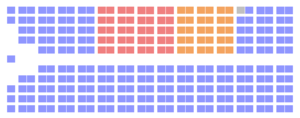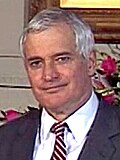Our website is made possible by displaying online advertisements to our visitors.
Please consider supporting us by disabling your ad blocker.
1984 Canadian federal election
| |||||||||||||||||||||||||||||||||||||||||||||||||||||
282 seats in the House of Commons 142 seats needed for a majority | |||||||||||||||||||||||||||||||||||||||||||||||||||||
|---|---|---|---|---|---|---|---|---|---|---|---|---|---|---|---|---|---|---|---|---|---|---|---|---|---|---|---|---|---|---|---|---|---|---|---|---|---|---|---|---|---|---|---|---|---|---|---|---|---|---|---|---|---|
| Opinion polls | |||||||||||||||||||||||||||||||||||||||||||||||||||||
| Turnout | 75.3%[1] ( | ||||||||||||||||||||||||||||||||||||||||||||||||||||
| |||||||||||||||||||||||||||||||||||||||||||||||||||||
 The Canadian parliament after the 1984 election | |||||||||||||||||||||||||||||||||||||||||||||||||||||
| |||||||||||||||||||||||||||||||||||||||||||||||||||||

The 1984 Canadian federal election was held on September 4, 1984, to elect members to the House of Commons of the 33rd Parliament of Canada.
In the largest landslide victory in Canadian political history, the Progressive Conservative Party (PC Party), led by Brian Mulroney, defeated the incumbent governing Liberal Party led by Prime Minister John Turner. This was the first election since 1958 in which the PC Party won a majority government and is also the only time since 1958 that Canada's governing party received an actual majority of votes cast.
Mulroney's victory came as a result of his building of a 'grand coalition' that comprised social conservatives from the West, Red Tories from the East, Quebec nationalists, and fiscal conservatives. Mulroney's PCs won the largest number of seats in Canadian history at 211. Winning 74.8 percent of the seats in the House of Commons, meant they won the second-largest percentage of seats in Canadian history. Only Progressive Conservative Prime Minister John Diefenbaker's triumph in the 1958 federal election, at 78.5 percent, was higher. This was the last time that the winning party won every province and territory and the last time that the winning party received over 50 percent of the national popular vote. The Liberals suffered what at that time was the worst defeat for a governing party at the federal level (in terms of percentage of seats). The New Democratic Party (NDP) saw no significant change to their seat count.
The election marked the end of the Liberals' long dominance of federal politics in Quebec, a province which had been the bedrock of Liberal support for almost a century. They would not win a majority of Quebec seats again until three decades later in 2015.
- ^ Pomfret, R. "Voter Turnout at Federal Elections and Referendums". Elections Canada. Archived from the original on September 28, 2010. Retrieved January 11, 2014.
Previous Page Next Page







